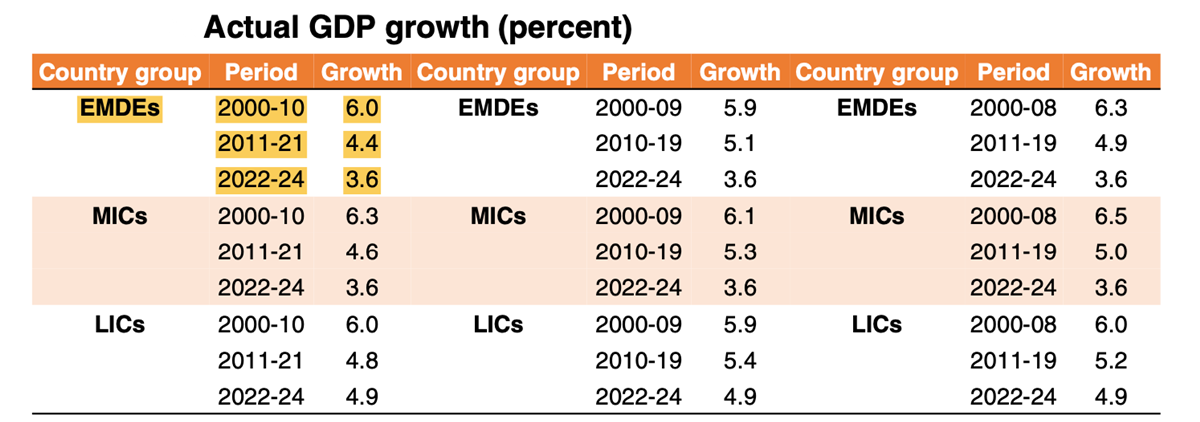Economy
Falling Long-Term Growth Prospects
- 31 Mar 2023
- 5 min read
For Prelims: World Bank, EMDEs, South Asia Region, GDP.
For Mains: Falling Long-Term Growth Prospects.
Why in News?
Recently, the World Bank (WB) has released a report titled “Falling Long-Term Growth Prospects: Trends, Expectations, and Policies", stating that the current decade (2020-2030) could be a lost decade for the whole world.
- The report uses a comprehensive database of multiple measures of potential growth.
- It examines trends in potential growth and its drivers, global and regional prospects for potential growth and investment over the 2020s, and a range of policy options to lift potential growth.
What are the Findings of the Report?
- Overview:
- Today nearly all the economic forces that drove economic progress are in retreat.
- There has been a protracted, broad-based decline in potential growth and its underlying drivers.
- The slowdown in potential growth is expected to persist for the rest of this decade.
- A decline in long-term growth prospects imperils the ability of Emerging Market and Developing Economies (EMDEs) to combat poverty, tackle climate change, and meet other key development objectives.
- Reasons for Slowdown:
- The biggest reason for the slowdown is that the EMDEs are in the midst of a prolonged period of weakness.

- The World Bank has looked at a whole set of fundamental drivers that determine economic growth and found that all of them have been losing power.
- These fundamental drivers include things like capital accumulation (through investment growth), labor force growth, and the growth of total factor productivity (which is the part of economic growth that results from more efficient use of inputs and which is often the result of technological changes) etc.
- The biggest reason for the slowdown is that the EMDEs are in the midst of a prolonged period of weakness.
- Observations about India:
- Although India has also lost its growth momentum over the past two decades, it is and will likely remain a global leader when it comes to growth rates.
- India falls under the South Asia Region (SAR), which is expected to be fastest growing among emerging market and developing economies for the remainder of this decade.
- SAR includes countries like Afghanistan, Pakistan, Sri Lanka, Nepal and Bangladesh etc.
- Output in the region is on track to grow by about 6.0 % a year between 2022 and 2030, faster than the 2010's annual average of 5.5 %.
What are the Recommendations to boost Potential Global Growth?
- Monetary Fiscal and Financial Frameworks:
- Robust macroeconomic and financial policy frameworks can curb the turmoil in business cycles.
- Policymakers should prioritize taming inflation, ensuring financial-sector stability, reducing debt, and restoring fiscal prudence.
- Scale up Investments:
- Transportation and energy, climate-smart agriculture and manufacturing, and land and water systems.
- In the above-mentioned areas, sound investments aligned with key climate goals could enhance potential growth by up to 0.3 % per year.
- Reduce Trade Costs:
- Trade costs effectively double the cost of internationally traded goods today.
- Countries with the highest shipping and logistics costs could cut their trade costs in half by adopting the trade-facilitation and other practices of countries with the lowest shipping and logistics costs.
- Capitalize on Services:
- The services sector could become the new engine of economic growth.
- Exports of digitally delivered professional services related to information and communications technology climbed to more than 50% of total services exports in 2021, up from 40% in 2019.
- Increase Labor Force:
- About half of the expected slowdown in potential GDP (Gross Domestic Product) growth through 2030 will be attributable to changing demographics.
- This change includes a shrinking working-age population and declining labor force participation as societies age.
- Boosting overall labor force participation rates by the best ten-year increase on record could increase global potential growth rates by as much as 0.2 percentage point a year by 2030.
UPSC Civil Services Examination Previous Year Question (PYQ)
Q1. India’s ranking in the ‘Ease of Doing Business Index’ is sometimes seen in the news. Which of the following has declared that ranking? (2016)
(a) Organization for Economic Cooperation and Development (OECD)
(b) World Economic Forum
(c) World Bank
(d) World Trade Organization (WTO)
Ans: (c)




